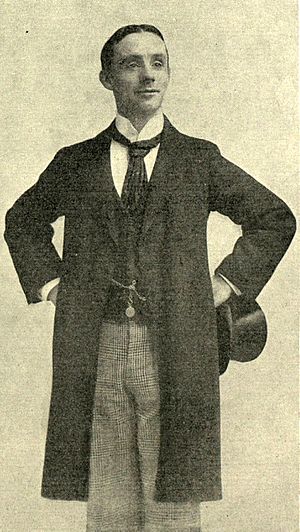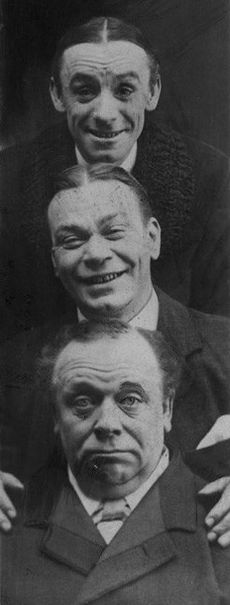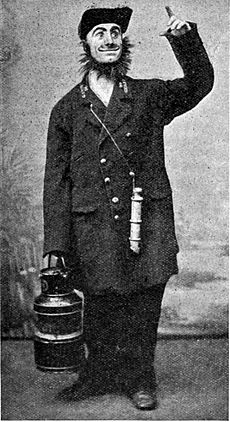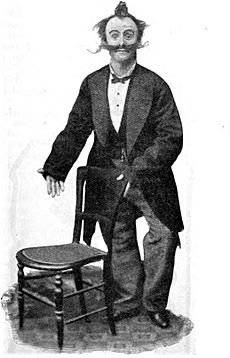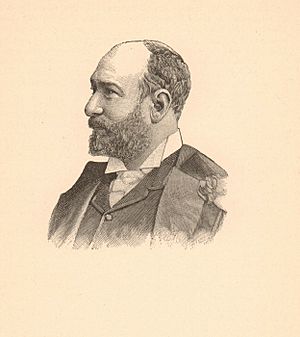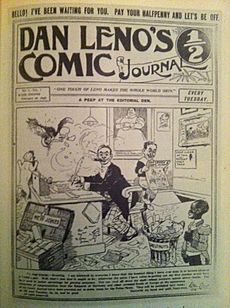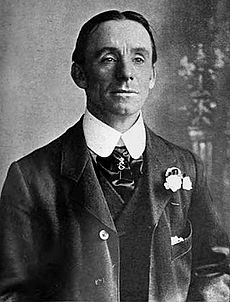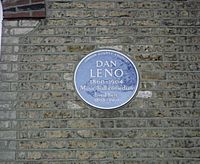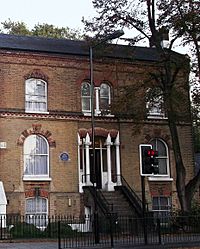Dan Leno facts for kids
George Wild Galvin (born December 20, 1860 – died October 31, 1904) was a very famous English comedian and actor. He was known by his stage name, Dan Leno. He was a big star in music halls and musical theatre during the late Victorian era. People especially loved his roles as a pantomime dame in the yearly pantomime shows. These shows were very popular at London's Theatre Royal, Drury Lane, from 1888 to 1904.
Dan Leno was born in St Pancras, London. He started performing when he was a child. In 1864, he joined his parents on stage in their music hall act. He made his first solo appearance at age nine in Coventry. When he was young, he was famous for his clog dancing. As a teenager, he became the main star of his family's show. He chose the stage name Dan Leno. In 1884, he performed under this name for the first time in London.
As a solo artist, Dan Leno became super popular in the late 1880s and 1890s. He was one of the highest-paid comedians in the world! His music hall act involved talking about everyday life. He mixed this with funny songs and silly, dream-like observations. He also created many characters, mostly working-class people, to tell his stories. In 1901, when he was still at the top of his career, he performed for Edward VII at Sandringham. The King was so impressed that Dan Leno became known as "the king's jester." He was also very kind and helped many performers in need through charity work.
Contents
Dan Leno's Early Life and Family
Dan Leno was born in St Pancras, London. He was the youngest of six children. His parents, John Galvin and Louisa Dutton, were also performers. They had a music hall act called "The Singing and Acting Duettists." They were known as Mr. and Mrs. Johnny Wild. They didn't earn much money, and the family was quite poor.
Since he grew up with performers, Dan Leno learned to entertain as a child. He didn't have much schooling. In 1864, when he was four, he joined his parents on stage for the first time. He was billed as "Little George, the Infant Wonder."
When Dan Leno was four, his father passed away. The family then moved to Liverpool. His mother married William Grant in 1866. William Grant was a comedian who performed in music halls. He used the stage name William Leno. The family moved north to Liverpool. They performed in many halls and theatres there. They also often returned to London to perform.
Starting His Career
In 1865, Dan Leno and his brother Henry formed a clog dancing act. They called themselves "The Great Little Lenos." This was the first time Dan Leno used his stepfather's stage name, "Leno." In the same year, Dan Leno also appeared in his first pantomime in Liverpool. He played a young clown.
In 1867, the brothers performed without their parents for the first time. This was at the Britannia music hall in Hoxton. They were successful at first. But they often had no work and had to perform on the street to earn money. Henry later left the act to learn a trade. This made Dan Leno think about performing alone. Sometimes, their uncle, Johnny Danvers, who was close to Dan Leno, would fill in for Henry.
Dan Leno started performing solo in 1869. He returned to the Britannia music hall. He became known as "The Great Little Leno." This name was suggested by his stepfather. It was meant to appeal to Irish audiences. In Ireland, Dan Leno also performed alone under the name "Dan Patrick." This helped him earn extra money. During this tour, the Lenos performed in a pantomime. Charles Dickens was in the audience and told young Dan Leno: "Good little man, you'll make headway!"
Throughout the 1870s, Dan Leno and his parents performed as "The Comic Trio." Young Dan Leno often played the main role in their comedy acts. One of his favorite acts was "Pongo the Monkey." In this show, Dan Leno played an escaped monkey.
As a teenager, Dan Leno became more and more popular. He performed in many theatres. His clog dancing was so good that in 1880, he won the world championship in Leeds. He received a special gold and silver belt for it. His biographer said that he danced without saying a word.
Becoming a Star in the 1880s
In 1878, Dan Leno and his family moved to Manchester. There, he met Lydia Reynolds. She was a dancer and singer. In 1883, Lydia joined the Leno family theatre company. Dan Leno and Lydia got married in 1884. Around this time, he officially started using the stage name "Dan Leno."
In 1884, the Leno family took over the Grand Varieties Theatre in Sheffield. They felt comfortable with the working-class audiences there. On their first night, over 4,000 people came to see Dan Leno. In 1885, Dan Leno and his wife moved to London. Dan Leno became very successful with his solo act. It included comedy talk, dancing, and songs.
When he first performed in London, he appeared in three music halls on the same night! He earned £5 a week. At first, he was called "The Great Irish Comic Vocalist and Clog Champion." But he slowly stopped dancing as much. Instead, he focused on creating funny characters. These included "Going to Buy Milk for the Twins" and "The Railway Guard." His London audiences loved these comedy acts and songs more than his dancing.
In 1888, Dan Leno appeared in a musical comedy called Atalanta. He played the role of Leontes. He joined the show quickly and didn't have much time to learn the script. But his funny, unplanned comedy helped the show become more popular.
Music Hall Performances
In the 1890s, Dan Leno was the top performer in music halls. He created characters based on people he saw in London. These included shopwalkers, grocers, beefeaters, firemen, and many others. He also played fathers, husbands, and talkative wives.
One of his famous characters was Mrs. Kelly, a gossip. Dan Leno would sing a song, then start talking. He would often say, "You know Mrs. Kelly?" This became a very well-known catchphrase.
For his London shows, Dan Leno bought songs from the best music hall writers. From 1890, George Le Brunn wrote music for many of his songs. These included "The Detective," "My Old Man," and "The Shopwalker." Le Brunn also wrote music for three of Dan Leno's most famous songs about everyday jobs: "The Railway Guard" (1890), "The Shopwalker," and "The Waiter" (both from 1891). These songs became very popular. Dan Leno would sometimes change the characters to keep the acts fresh and funny.
In "The Railway Guard," Dan Leno played a wild railway station guard. He wore a messy uniform and had a whistle. He created this character by making fun of a real employee he saw. This employee was always getting involved in other people's business instead of doing his work.
"The Shopwalker" was full of funny jokes. Dan Leno played a shop assistant who was very energetic. He would try to get imaginary customers into the shop. Then he would sing about his crazy selling methods. In "The Waiter," Dan Leno wore a huge dinner jacket and a loose white shirt front. The shirt front would flap up and hit his face! He played a waiter who felt sorry for himself and was easily offended.
Pantomime Shows
Dan Leno's first pantomime in London was Jack and the Beanstalk in 1886. He played Dame Durden. The show was a big hit, and Dan Leno got great reviews. Because of this, he was hired for the next year's pantomime, Sinbad and the Little Old Man of the Sea.
After these popular shows, Dan Leno was hired in 1888 by Augustus Harris. Harris was the manager of the Theatre Royal, Drury Lane. He wanted Dan Leno to be in the Christmas pantomime, Babes in the Wood. Harris's pantomimes at this huge theatre were known for being very grand and fancy. They had over a hundred performers, dancers, acrobats, and animals.
Babes in the Wood was a huge success! The theatre had record numbers of people coming to see it. Dan Leno started doing fewer music hall shows because of this. He performed with Herbert Campbell and Harry Nicholls in the next fifteen Christmas pantomimes at Drury Lane. After Harris passed away in 1896, Arthur Collins became the manager. He continued to oversee the pantomimes.
In their pantomimes, the small Dan Leno and the large Herbert Campbell made a very funny pair. They often didn't stick to the script and made things up as they went along. This made the shows even funnier. The writer George Bernard Shaw and the essayist Max Beerbohm sometimes thought their unplanned jokes weren't always the best. However, Beerbohm noted that Dan Leno was special because he gave each of his dame characters their own unique personality.
Dan Leno loved playing the dame roles in two of his last pantomimes: Bluebeard (1901) and Mother Goose (1902). He was paid £200 for each pantomime season. In Bluebeard, Dan Leno played Sister Anne. A critic said he was "a quite peculiar and original Sister Anne." He danced, sang strange songs, and played ping-pong with a frying pan! Mother Goose was one of his most challenging roles. He had to play the same woman in many different ways. The show was one of Drury Lane's most successful pantomimes.
Later Career and Fame
In 1896, a show producer named Milton Bode offered Dan Leno a role in a musical comedy called Orlando Dando, the Volunteer. Dan Leno's agent said no at first because Dan Leno was already booked for two years. But when Bode offered £625 for just six weeks, Dan Leno accepted! He toured the country with the show and it was an instant hit. He was so popular that Bode hired him for two more shows: In Gay Piccadilly! (1899) and Mr. Wix of Wickham (1902).
In 1897, Dan Leno went to America. He performed at Hammerstein's Olympia Music Hall on Broadway. He was called "The Funniest Man on Earth." Some people loved his show, but others thought his English humor was old-fashioned. His American trip ended after a month. Dan Leno said it was "the crown of my career." Even so, he turned down all future offers to tour America and Australia because of the few negative reviews.
The same year, Dan Leno started his own newspaper called Dan Leno's Comic Journal. It was for young adults. It featured a special, made-up version of Dan Leno. This was the first time a comic paper was named after a living person. The paper sold 350,000 copies a year! Dan Leno wrote most of the funny stories and jokes. He also had control over what was published. The paper had slogans like "One Touch of Leno Makes the Whole World Grin." It ran for almost two years before Dan Leno lost interest.
A journalist wrote in the late 1890s that Dan Leno was "probably the highest paid funny man in the world." In 1898, Dan Leno, Herbert Campbell, and Johnny Danvers worked together to build the Granville Theatre in Fulham. Dan Leno also published his autobiography, Dan Leno: Hys Booke, in 1899.
Between 1901 and 1903, Dan Leno recorded more than twenty-five songs and monologues. He also made 14 short films. In these films, he played a clumsy character who struggled with everyday things, like riding a bicycle.
On November 26, 1901, Dan Leno was invited to Sandringham House. He performed for King Edward VII, Queen Alexandra, and other royal family members. Dan Leno performed a thirty-five-minute solo act. It included two of his famous songs: "How to Buy a House" and "The Huntsman." After the show, the King gave Dan Leno a special tie pin with jewels. From then on, Dan Leno was known as "the King's Jester." He was the first music hall performer to do a Royal Command Performance for the King.
Personal Life and Charity Work
In 1883, Dan Leno met Sarah Lydia Reynolds. She was a young dancer and singer from Birmingham. They met while performing at a circus. Lydia was already a talented actress as a teenager. She and Dan Leno got married in 1884. They had a daughter named Georgina. Later, they had three more children: Ernest, Sidney, and May. All of them followed their father into performing. Sidney later performed as Dan Leno, Jr. Dan Leno also supported his mother and stepfather financially after they stopped performing.
Dan Leno owned some land behind his house in Clapham Park. He grew vegetables and raised chickens there. In 1898, Dan Leno and his family moved to 56 Akerman Road, Lambeth. A blue plaque was put on this house in 1962 to remember him.
Helping Others
Dan Leno was very active in charity work. He helped performers who needed money. He was a member of the Grand Order of Water Rats. This charity helps performers who are in financial trouble. He was also the leader of this group several times. Near the end of his life, Dan Leno helped start The Music Hall Artistes Railway Association. This group worked with the Water Rats to form the first trade union for music hall performers. Dan Leno also helped people quietly, without telling everyone.
In the late 1890s, Dan Leno started a cricket team called the "Dainties." He asked many famous comedians and music hall stars to join. They played charity matches against other teams. Their silly behavior on the field made large crowds laugh. From 1898 to 1903, the Dainties played matches all over London. Two films were even made of their matches in 1900. In 1901, at a big charity match, the comedians wore funny costumes. Dan Leno dressed as an undertaker and later as a schoolgirl riding a camel! Bands played, and clowns walked through the crowd. 18,000 people came to watch. They helped raise money for charities that supported music hall performers and cricketers.
Later Years and Passing
Towards the end of his life, Dan Leno's health began to decline. He sometimes had trouble remembering his lines and speaking clearly on stage. In 1901, during a show, he missed his cue and was stuck up a tower for over twenty minutes! At the end of his show Mother Goose in 1903, the producer Arthur Collins gave him a special silver dinner set. Dan Leno stood up and joked, "Governor, it's a magnificent present! I congratulate you and you deserve it!"
Dan Leno was very keen to be seen as a serious actor. He wanted to play big Shakespearean roles like Richard III. He kept asking the actor–manager Herbert Beerbohm Tree about this. After his last show of Mother Goose in early 1903, Dan Leno's mind became very confused. He visited the home of actress Constance Collier and tried to convince her to act with him in Shakespearean plays. He even brought her a diamond brooch. Constance Collier realized he was having a difficult time. She gently refused his offer.
Two days later, he was admitted to a special hospital for care. Dan Leno stayed there for several months. He tried to leave a few times and even succeeded twice, but he was always brought back.
Dan Leno was released from the hospital in October 1903. People were happy to hear he was out. They wondered if he would be in the next Drury Lane pantomime, Humpty Dumpty. The producer, Arthur Collins, was worried Dan Leno might get sick again. So, he hired Marie Lloyd to take his place. But Dan Leno convinced Collins that he was well enough to perform. He appeared in the show and was a success. The audience gave him a five-minute standing ovation after he sang his famous song. He even received a telegram from the King congratulating him.
Dan Leno's stage partner, Herbert Campbell, passed away in July 1904. This made Dan Leno very sad, and his health got worse. He was performing at the London Pavilion, but the show had to be canceled because he couldn't remember his lines. The critics were very harsh. Dan Leno wrote a statement to defend his show.
On October 20, 1904, Dan Leno gave his last performance. Afterwards, he stopped at the Belgrave Hospital for Children in Kennington to leave a donation. He was the vice-president of that hospital.
Dan Leno passed away at his home in London on October 31, 1904, at the age of 43. He was buried at Lambeth Cemetery, London. His death and funeral were big news across the country. The Daily Telegraph wrote that "There was only one Dan. His methods were inimitable; his face was indeed his fortune..." Max Beerbohm later said that Dan Leno was like "So little and frail a lantern could not long harbour so big a flame."
Dan Leno is remembered by the Dan Leno Gardens in London. These gardens are for people with disabilities.
Images for kids
See also
 In Spanish: Dan Leno para niños
In Spanish: Dan Leno para niños


